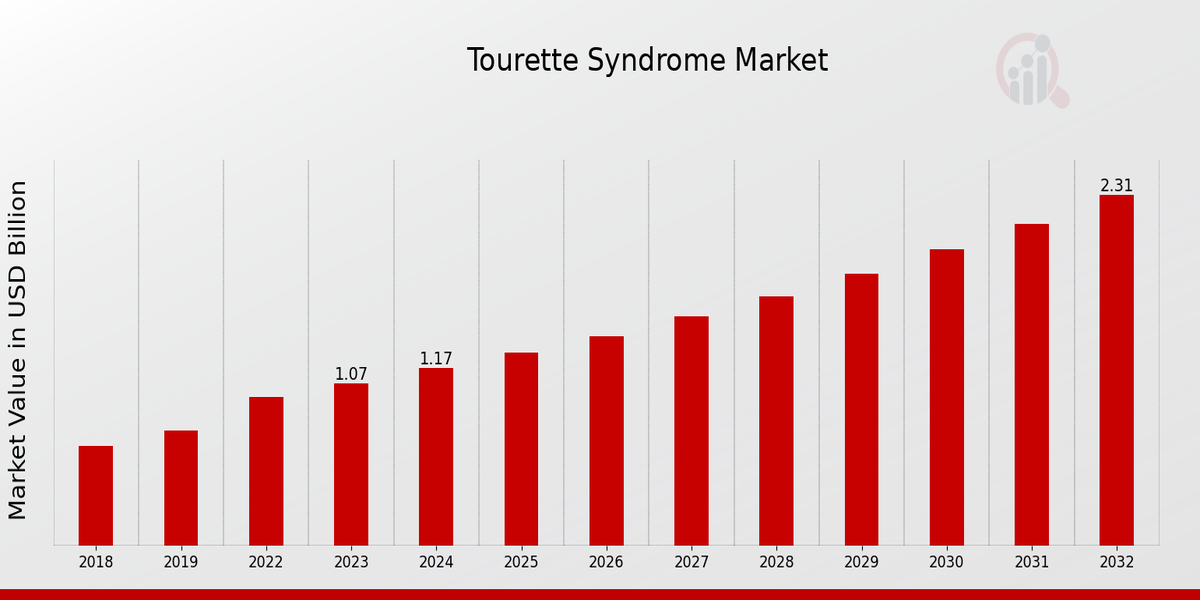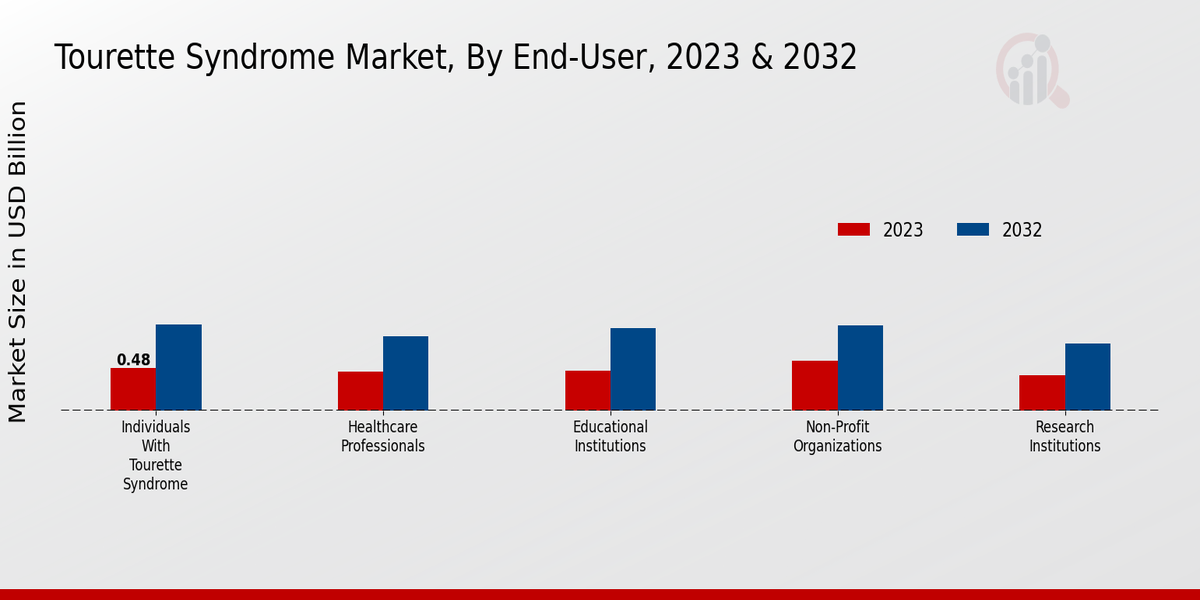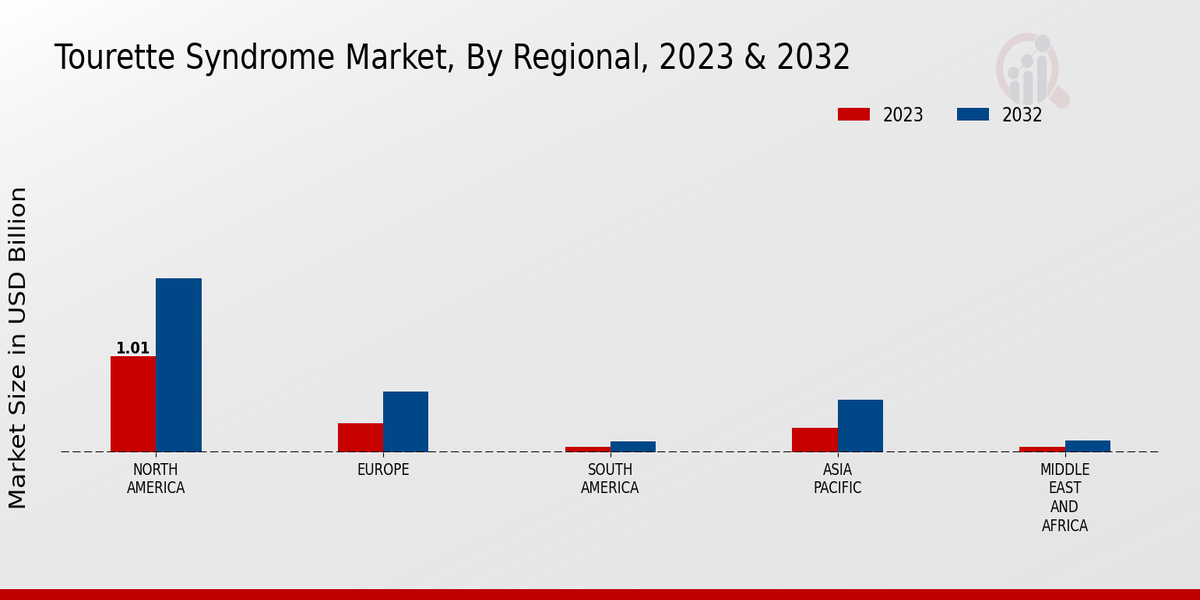Tourette Syndrome Market Overview
As per MRFR analysis, the Tourette Syndrome Market Size was estimated at 1.22 (USD Billion) in 2023. The Tourette Syndrome Market Industry is expected to grow from 1.29 (USD Billion) in 2024 to 2 (USD Billion) by 2032. The Tourette Syndrome Market CAGR (growth rate) is expected to be around 5.64% during the forecast period (2024 - 2032).
Key Tourette Syndrome Market Trends Highlighted
The Tourette Syndrome market has gained significant attention due to its increasing prevalence and the rising demand for effective treatments. Key market drivers include growing awareness about the condition, advances in diagnostic techniques, and the development of innovative therapeutic approaches.
Opportunities for market growth lie in expanding access to healthcare services, particularly in underserved regions, and the exploration of novel therapies, such as gene therapy and deep brain stimulation.
Recent trends in the market include the integration of technology in diagnosis and treatment, the personalization of treatment plans, and the increasing focus on co-occurring conditions associated with Tourette Syndrome.
These factors contribute to the expanding market landscape and offer opportunities for stakeholders to address the evolving needs of patients and their families.

Source: Primary Research, Secondary Research, Market Research Future Database and Analyst Review
Tourette Syndrome Market Drivers
Increasing Prevalence of Tourette Syndrome
Tourette Syndrome is classified as a neurodevelopmental disorder, and it is characterized by tics – that is, by involuntary movements or vocalizations, which the affected individual tends to repeat frequently.
The incidence of the condition is increasing across the globe, and it is estimated that 1% of all children and adolescents worldwide are diagnosed with the condition.
This increase in incidence is likely attributable to multiple factors, such as the overall increase in awareness and diagnostic practices among medical professionals, as well as the potentially increasing prevalence of factors capable of triggering the tics.
The growing incidence, however, requires a corresponding response, and that demand results in the increasing size of the Tourette Syndrome Market Industry.
Rising Demand for Novel Therapies
The rising demand for novel therapies is also boosting the Tourette Syndrome Market Industry. Though traditional therapies such as behaviour therapy and medication existed there, they were not as effective and were seen to have various side effects.
The new therapies that are currently in development, deep brain stimulation, Tra-cranial magnetic stimulation and gene therapy, are also expected to be approved commercially soon. All these new therapies are also making the Tourette Syndrome Market Industry to grow.
Increasing Government Support for Research and Development
Government support for research and development is another big driver of the Tourette Syndrome Market Industry. Governments worldwide are recognizing the prevalence of Tourette Syndrome and they are offering funding to encourage research of new treatments and therapies.
This support will enhance the development of newer and more efficient therapies against Tourette Syndrome, and they are therefore expected to fuel more growth in the Tourette Syndrome Market Industry in the future.
Tourette Syndrome Market Segment Insights
Tourette Syndrome End-User Insights
The Tourette Syndrome Market is segmented by End-User into Individuals with Tourette Syndrome, Healthcare Professionals, Educational Institutions, Non-Profit Organizations and Research Institutions. The market segment of Individuals with Tourette Syndrome contributed the greatest share to the market revenue, which was approximately 45% in 2023.
The Healthcare Professionals’ market segment is expected to grow greatly over the years of the forecast, due to the increasing prevalence of the Tourette Syndrome and the growing need for special care.
The market of Educational Institutions is also likely to contribute to the growth, as there is increasing awareness of the disease and the need for schools to provide support and education.
The role of Non-Profit Organizations is vital, as they provide important support for Individuals with Tourette Syndrome and their relatives; as a result, their market share is likely to increase as the demand for their services grows. The market of Research Institutions, in turn, is going to grow as their role in discovering new treatments and therapies for Tourette Syndrome is expanding.
Overall, the Tourette Syndrome Market is going to amount to 1.23 billion USD in 2024, growing at a CAGR of 9.1% during the forecast period.

Source: Primary Research, Secondary Research, Market Research Future Database and Analyst Review
Tourette Syndrome Type of Treatment Insights
The Tourette Syndrome Market Segmentation by Type of Treatment includes Medications, Behavioural Therapy, Neuromodulation Devices Therapies, Complementary and Alternative Medicine, and Other Therapies.
Medications held the largest market share in 2023, owing to the widespread use of drugs like alpha-2 agonists, dopamine antagonists, and antipsychotics. Behavioural Therapy is projected to witness the highest CAGR during the forecast period, due to its effectiveness in managing tics and improving social functioning.
Neuromodulation Therapies, such as Deep Brain Stimulation (DBS) and Transcranial Magnetic Stimulation (TMS), offer promising treatment options for severe cases of Tourette Syndrome.
Complementary and Alternative Medicine, including acupuncture and herbal remedies, are gaining popularity as adjunctive therapies. Other Therapies, such as habit reversal training, support groups, and educational interventions, play a crucial role in managing the condition.
The Tourette Syndrome Market revenue from Medications segment is expected to reach USD 0.64 billion by 2032, growing at a CAGR of 8.2%.
Tourette Syndrome Severity of Symptoms Insights
The severity of symptoms is a key segmentation factor in the Tourette Syndrome Market. The market is divided into three segments based on the severity of symptoms: mild, moderate, and severe.
The mild segment is expected to account for the largest share of the market in 2023, with a market value of USD 0.61 billion. The moderate segment is expected to follow, with a market value of USD 0.32 billion.
The severe segment is expected to account for the smallest share of the market, with a market value of USD 0.14 billion. The market growth for the mild segment is expected to be driven by the increasing prevalence of Tourette Syndrome and the growing awareness of the condition.
The moderate segment is expected to grow at a steady pace, while the severe segment is expected to experience the slowest growth due to the limited number of treatment options available.
Tourette Syndrome Diagnostic Tools Insights
Diagnostic tools play a crucial role in identifying and assessing the severity of Tourette Syndrome. Clinical examination, diagnostic interviews, observational scales and neuroimaging techniques are widely used for diagnosis.
Clinical examination involves a physical examination and assessment of the patient's medical history and symptoms. Diagnostic interviews involve structured questionnaires and interviews to gather information about the patient's symptoms, family history, and environmental factors.
Observational scales, such as the Yale Global Tic Severity Scale, provide standardized methods for quantifying the frequency and severity of tics.
Neuroimaging techniques, including MRI and EEG, help visualize brain structures and assess brain activity patterns associated with Tourette Syndrome. The increasing prevalence of Tourette Syndrome and the growing awareness of its impact on individuals' lives are driving the demand for diagnostic tools.
Advancements in neuroimaging technology, such as the development of functional MRI, are enhancing diagnostic capabilities and providing insights into the underlying mechanisms of Tourette Syndrome. The availability of genetic testing is also contributing to the improved diagnosis and management of the condition.
Tourette Syndrome Therapeutic Interventions Insights
Cognitive Behavioral Therapy (CBT), Exposure and Response Prevention Therapy (ERP), Habit Reversal Training (HRT), Mindfulness-Based Interventions (MBIs), and Other Behavioural Interventions are essential therapeutic interventions in the Tourette Syndrome Market.
These therapies aim to modify maladaptive behaviours and thought patterns associated with Tourette Syndrome. In 2023, the Therapeutic Interventions segment is projected to reach a market value of USD 1.07 billion.
CBT is the most widely used intervention, helping individuals identify and challenge negative thoughts and behaviors. ERP involves gradually exposing individuals to anxiety-provoking situations while teaching them coping mechanisms. HRT focuses on replacing unwanted tics with more acceptable behaviours.
MBIs enhance self-awareness and emotional regulation. Other Behavioral Interventions include social skills training, parent training, and support groups. The increasing prevalence of Tourette Syndrome and growing awareness of therapeutic interventions drive market growth.
Tourette Syndrome Regional Insights
The Tourette Syndrome Market revenue was valued at 1.07 USD Billion in 2023, and it is projected to reach 2.31 USD Billion by 2032, exhibiting a CAGR of 8.93% during the forecast period.
Regionally, North America accounted for the largest market share in 2023, followed by Europe, APAC, South America and MEA.
North America's dominance can be attributed to the high prevalence of Tourette syndrome in the region, as well as the availability of advanced healthcare infrastructure and treatment options.
Europe is another significant market for Tourette syndrome treatment, driven by the presence of well-established healthcare systems and a large patient population.
APAC is expected to witness the fastest growth in the Tourette syndrome market during the forecast period, owing to the increasing awareness of the condition and the growing availability of treatment options in the region.
South America and MEA are expected to contribute a smaller share of the Tourette Syndrome Market, but they are also expected to experience steady growth in the coming years.

Source: Primary Research, Secondary Research, Market Research Future Database and Analyst Review
Tourette Syndrome Market Key Players And Competitive Insights
Major players in Tourette Syndrome industry are constantly striving to develop innovative treatments and therapies to address the unmet needs of patients. Leading Tourette Syndrome Market players are investing heavily in research and development to bring new products to market and expand their market share.
The Tourette Syndrome Market is highly competitive, with several established players and emerging challengers. Key players in this market include Neurelis, Inc., Xenon Pharmaceuticals, Inc., and Arbor Pharmaceuticals, LLC.
These companies are focused on developing and commercializing novel therapies for the treatment of Tourette Syndrome. Cerevel Therapeutics is a leading company in the Tourette Syndrome Market industry.
The company's lead product, inebilizumab, is a monoclonal antibody that targets the CD19 antigen in B cells. Inebilizumab has shown promising results in clinical trials for the treatment of Tourette Syndrome and is expected to be approved by the FDA in 2023.
Cerevel Therapeutics is also developing other novel therapies for the treatment of Tourette Syndrome, including a small molecule inhibitor of the sigma-1 receptor.
Another major player in the Tourette Syndrome Market is Neurocrine Biosciences, Inc. The company's lead product, valbenazine, is a selective vesicular monoamine transporter 2 (VMAT2) inhibitor that is approved for the treatment of Tourette Syndrome in adults and children.
Valbenazine has shown efficacy in reducing the severity of tics in patients with Tourette Syndrome and is generally well-tolerated.
Neurocrine Biosciences is also developing other novel therapies for the treatment of Tourette Syndrome, including a long-acting formulation of valbenazine.
Key Companies in the Tourette Syndrome Market Include
- Lundbeck
- UCB
- Abide Therapeutics
- Biogen
- Sunovion Pharmaceuticals
- Arbor Pharmaceuticals
- Catalyst Pharmaceuticals
- Bausch Health Companies
- Boehringer Ingelheim
- Xeris Pharmaceuticals
- Teva Pharmaceutical Industries
- Eli Lilly and Company
- Novartis
- Shire (now part of Takeda)
- Acorda Therapeutics
Tourette Syndrome Industry Developments
The Tourette Syndrome Market is anticipated to reach USD 2.31 billion by 2032, expanding at a CAGR of 8.93% from 2024 to 2032. Rising prevalence of Tourette Syndrome, growing awareness about the condition, and advancements in treatment options drive market growth.
Key developments include the approval of new therapies, such as Nuplazid and Gocovri, and the increasing adoption of behavioral therapies and deep brain stimulation. Strategic collaborations and acquisitions among market players are also shaping the competitive landscape.
Tourette Syndrome Market Segmentation
Tourette Syndrome End-User Outlook
- Individuals with Tourette Syndrome
- Healthcare Professionals
- Educational Institutions
- Non-Profit Organizations
- Research Institutions
Tourette Syndrome Type of Treatment Outlook
- Medications
- Behavioral Therapy
- Neuromodulation Therapies (e.g., DBS, TMS)
- Complementary and Alternative Medicine (e.g., acupuncture, herbal remedies)
- Other Therapies
Tourette Syndrome Severity of Symptoms Outlook
Tourette Syndrome Diagnostic Tools Outlook
- Clinical Examination
- Diagnostic Interviews
- Observational Scales (e.g., Yale Global Tic Severity Scale)
- Neuroimaging Techniques (e.g., MRI, EEG)
Tourette Syndrome Therapeutic Interventions Outlook
- Cognitive Behavioral Therapy
- Exposure and Response Prevention Therapy
- Habit Reversal Training
- Mindfulness-Based Interventions
- Other Behavioral Interventions
Tourette Syndrome Regional Outlook
- North America
- Europe
- South America
- Asia Pacific
- Middle East and Africa
| Report Attribute/Metric |
Details |
| Market Size 2023 |
1.22 (USD Billion) |
| Market Size 2024 |
1.29 (USD Billion) |
| Market Size 2032 |
2 (USD Billion) |
| Compound Annual Growth Rate (CAGR) |
5.64% (2024 - 2032) |
| Report Coverage |
Revenue Forecast, Competitive Landscape, Growth Factors, and Trends |
| Base Year |
2023 |
| Market Forecast Period |
2024 - 2032 |
| Historical Data |
2019 - 2023 |
| Market Forecast Units |
USD Billion |
| Key Companies Profiled |
Lundbeck, UCB, Abide Therapeutics, Biogen, Sunovion Pharmaceuticals, Arbor Pharmaceuticals, Catalyst Pharmaceuticals, Bausch Health Companies, Boehringer Ingelheim, Xeris Pharmaceuticals, Teva Pharmaceutical Industries, Eli Lilly and Company, Novartis, Shire (now part of Takeda), Acorda Therapeutics |
| Segments Covered |
End-User, Type of Treatment, Severity of Symptoms, Diagnostic Tools, Therapeutic Interventions, Regional |
| Key Market Opportunities |
1. Increasing awareness of TS 2. Growing prevalence of TS 3. Rising demand for effective therapies 4. Technological advancements in TS diagnosis and treatment 5. Government initiatives to support TS research |
| Key Market Dynamics |
1. Rising prevalence of Tourette syndrome 2. Increasing awareness of the condition 3. Growing demand for novel therapies 4. Technological advancements in diagnosis and treatment 5. Expanding market for personalized medicine |
| Countries Covered |
North America, Europe, APAC, South America, MEA |
Frequently Asked Questions (FAQ):
Tourette Syndrome Market size is expected to reach USD 1.22 Billion in 2023 and USD 2 Billion by 2032, exhibiting a CAGR of 5.64% during the forecast period.
North America is expected to dominate the Tourette Syndrome Market, accounting for a significant market share in 2023.
The key application of the Tourette Syndrome Market is in the treatment of tics and other symptoms associated with the disorder.
Some of the key competitors in the Tourette Syndrome Market include Revance Therapeutics, Inc., Acadia Pharmaceuticals, Inc. and Neurocrine Biosciences, Inc.
The Tourette Syndrome Market is expected to grow at a CAGR of 5.64% from 2024 to 2032.
The increasing prevalence of Tourette syndrome and the growing awareness of treatment options are driving the growth of the Tourette Syndrome Market.
The high cost of treatment and the lack of effective therapies are some of the challenges faced by the Tourette Syndrome Market.
The development of new and more effective treatments is expected to create opportunities for the Tourette Syndrome Market.
The trend toward personalized medicine and the use of technology in the diagnosis and treatment of Tourette syndrome are shaping the Tourette Syndrome Market.
The Tourette Syndrome Market is expected to grow steadily over the forecast period, driven by the increasing demand for effective treatments.

















